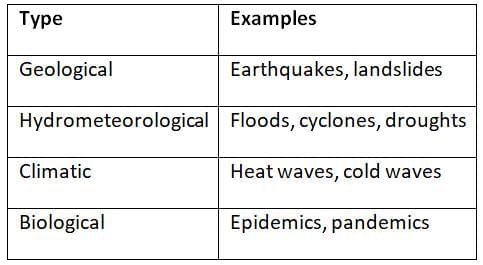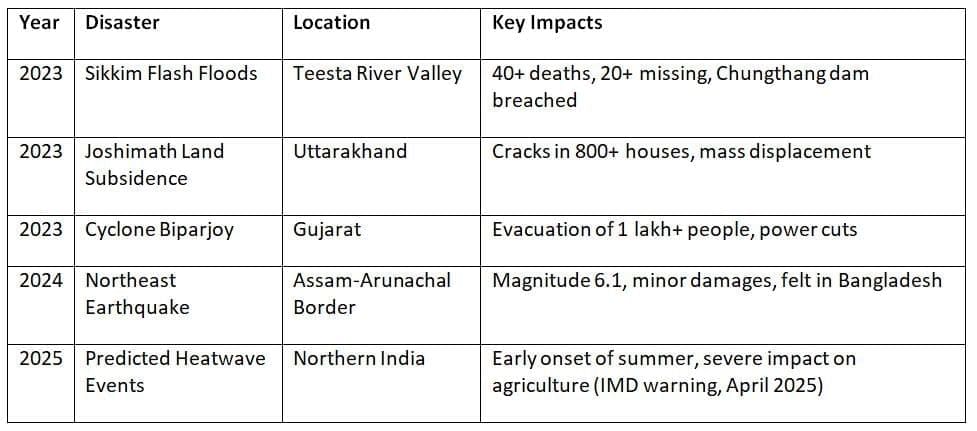UPSC Exam > UPSC Notes > Geography for UPSC CSE > Cheat Sheet: Natural Hazards & Disasters
Cheat Sheet: Natural Hazards & Disasters | Geography for UPSC CSE PDF Download
Key Concepts
- Hazard: A potential threat (natural or man-made) that can cause damage (e.g., earthquakes, floods).
- Disaster: When a hazard causes significant loss of life or property.
- Vulnerability: Exposure to hazards due to socio-economic or physical conditions.
Disaster Management Cycle:
- Preparedness
- Mitigation
- Response
- Recovery
Classification of Natural Hazards

Major Natural Disasters in India (Case Studies up to 2025)

India’s Vulnerability to Disasters
- Earthquakes: 59% of Indian landmass prone (Zones IV & V – Himalayan belt, NE India)
- Floods: 12% of land prone (Ganga-Brahmaputra Basin most affected)
- Cyclones: 8% coastal area prone (Odisha, Andhra Pradesh, Tamil Nadu, Gujarat most exposed)
- Droughts: ~68% of cultivable area vulnerable (Bundelkhand, Marathwada, Telangana)
- Landslides: Himalayan and Western Ghats regions
Institutional Framework
- Disaster Management Act, 2005: Legal framework post-2004 tsunami
- NDMA (National Disaster Management Authority): Apex body, chaired by PM
- SDMA, DDMA: State and district-level authorities
- Sendai Framework (2015–2030): Global agreement emphasizing disaster risk reduction (DRR)
Important Initiatives
- Aapda Mitra Scheme: Training of community volunteers
- CRED Data: Used for tracking global disaster trends
- NIDM: Training and research institution under Ministry of Home Affairs
- FLOWS (2024): Forecasting floods using AI by IMD and IITs
- Heat Action Plans: Implemented in Gujarat, Maharashtra, Odisha
Link with Environment & Climate Change
- Climate-induced disasters: Heatwaves, floods, and cyclones are rising due to global warming
- Urbanisation: Increases vulnerability due to unplanned growth (e.g., Chennai floods)
- Deforestation & Encroachments: Trigger landslides (e.g., Himachal 2023 monsoon slides)
The document Cheat Sheet: Natural Hazards & Disasters | Geography for UPSC CSE is a part of the UPSC Course Geography for UPSC CSE.
All you need of UPSC at this link: UPSC
|
175 videos|619 docs|192 tests
|
FAQs on Cheat Sheet: Natural Hazards & Disasters - Geography for UPSC CSE
| 1. What are the main classifications of natural hazards? |  |
Ans. Natural hazards can be classified into several categories based on their origin and impact. The primary classifications include geological hazards (such as earthquakes and volcanic eruptions), meteorological hazards (like cyclones and storms), hydrological hazards (floods and tsunamis), and biological hazards (such as epidemics). Understanding these classifications helps in better preparedness and response strategies.
| 2. What are some major natural disasters that have affected India? |  |
Ans. India has experienced several significant natural disasters, including the Bhuj earthquake in 2001, the 2004 Indian Ocean tsunami, and the floods in Uttarakhand in 2013. Each of these disasters caused extensive loss of life and property, highlighting the need for effective disaster management and mitigation strategies.
| 3. How vulnerable is India to natural disasters? |  |
Ans. India is highly vulnerable to natural disasters due to its diverse geography, climatic conditions, and high population density. Regions such as the Himalayan belt are prone to earthquakes and landslides, while coastal areas face threats from cyclones and tsunamis. This vulnerability is exacerbated by factors like urbanization, deforestation, and climate change.
| 4. What is the institutional framework for disaster management in India? |  |
Ans. The institutional framework for disaster management in India includes the National Disaster Management Authority (NDMA), State Disaster Management Authorities (SDMAs), and various local authorities. The NDMA is responsible for policy formulation and coordination of disaster management efforts at the national level, while SDMAs handle state-specific issues.
| 5. What initiatives has India taken to address natural disasters and their impacts? |  |
Ans. India has launched several initiatives to improve disaster management, such as the National Policy on Disaster Management, the establishment of the NDMA, and various capacity-building programs. Additionally, the country has emphasized community-based disaster risk management and the integration of disaster preparedness into development planning to enhance resilience.
Related Searches





















